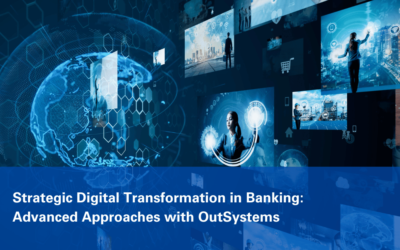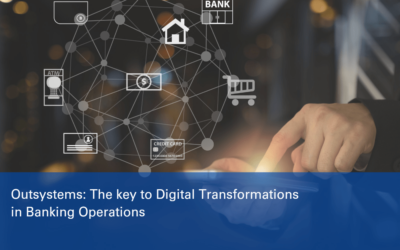The insurance industry is facing a significant challenge – digital disruption. With customers becoming increasingly “switchy,” insurance companies are under pressure to retain their customer base. The expectations of customers are evolving, and they now demand the same seamless and frictionless experience from their insurance providers that they get from B2C giants like Amazon.
In this blog post, we will explore how insurance companies can leverage application modernization to address industry problems and build and evolve user-friendly insurance apps that cater to the needs of today’s digital-savvy customers.
Businesses and the Insurance industry must not only transform but also evolve continuously to stay ahead. This evolution is not just about keeping up with the latest trends but also about anticipating and adapting to future changes. It’s about being agile and responsive, ready to pivot when necessary. This is where OutSystems comes in. With its low-code capabilities, OutSystems enables businesses to transform their operations quickly and efficiently. It allows them to build apps and digital experiences that are not only user-friendly but also scalable and adaptable.
This means businesses can evolve their digital presence as their needs change, ensuring they stay relevant and competitive in an ever-changing market. customers expect smooth and easy experiences whenever they interact with a company. Anything less than that is a poor experience that can affect how many people use your app, how engaged they are, and how long they stick around. This, in turn, affects how much money your business makes.
Understanding OutSystems and its Low-Code Capabilities:
In the insurance domain, customer engagement and operational efficiency are paramount. Insurers need to provide seamless digital experiences to their customers while streamlining their internal processes. This is where low-code development platforms like OutSystems come into play, offering a range of capabilities that can transform the insurance industry.
OutSystems is a platform that helps companies build apps quickly and easily. It’s called a “low-code” platform because it uses a lot of pre-made pieces, so you don’t have to write as much code yourself. This makes it faster to build apps, which means you can respond more quickly when the market changes.
Discuss the Need for Digital Transformation in the Insurance Industry:
Insurance companies need to change the way they do things if they want to stay competitive. They need to use technology to make things easier for their customers, or they’ll get left behind.
- Competition: There are a lot of insurance companies out there, and they’re all competing for the same customers. To stand out, companies need to offer something different. Digital transformation can help them do that.
- Customer Experience: Insurers need to provide seamless and convenient services to their customers, and one way to do this is through a self-service portal. This portal allows customers to manage their policies, file claims, and access important information without having to speak to a representative.
- Employee Productivity: keeping the priorities in mind they made their digital solutions with outsystems, employees can work on their self service portal. It can help them automate repetitive tasks, reduce the need for manual data entry, and make it easier for employees to collaborate
- Efficiency: Digital transformation can make insurance companies more efficient. It can help them process claims faster, reduce paperwork, and save money.
- Regulatory Compliance: Insurance companies need to comply with a lot of regulations. Digital transformation can help them keep track of these regulations and make sure they’re following them.
- Innovation: Digital transformation can help insurance companies innovate. It can help them come up with new products and services that meet the changing needs of their customers.
- Cost Savings: Digital transformation can help insurance companies save money. It can help them reduce the cost of processing claims, reduce the cost of customer service, and reduce the cost of compliance.
- Risk Management: Digital transformation can help insurance companies manage risk better. It can help them identify and mitigate risks before they become problems.
Key Challenges and Opportunities for Customer Engagement in the Digital Era:
One of the biggest challenges for insurance companies is keeping their customers engaged. People don’t like dealing with insurance companies, so it’s important to make things as easy as possible for them.
This is where technology can help. Customers now expect a seamless and personalized experience from their insurance providers. They want to be able to access their policies, file claims, and get support quickly and easily. The insurance industry is constantly evolving, with new products, regulations, and market trends emerging all the time. Insurers need to be able to adapt quickly to these changes in order to stay competitive.
Many insurers still rely on legacy systems for core functions such as policy administration and claims processing. These systems can be difficult to integrate with modern customer engagement platforms, leading to a disjointed and inefficient customer experience.
Purposed Solutions:-
User-Friendly Insurance Apps: One of the key aspects of application modernization is building and evolving user-friendly insurance apps. These apps should be accessible via mobile, portals, SMS, and IoT devices, allowing customers to engage with their insurance provider 24/7. By providing customers with easy access to information and services, insurance companies can improve customer satisfaction and loyalty.
Leveraging Mobile: Mobile apps are becoming increasingly popular among insurance customers, especially younger consumers. Insurance companies can leverage mobile apps to provide customers with instant access to their policies, claims, and other important information. Mobile apps can also be used to send push notifications and alerts, keeping customers informed about important updates and events.
Portals and SMS: Portals and SMS are also important channels for engaging with customers. Insurance companies can use portals to provide customers with a personalized and interactive experience. SMS can be used to send reminders, updates, and other important information directly to customers’ phones, ensuring that they stay informed and engaged.
IoT: The Internet of Things (IoT) is another emerging technology that insurance companies can leverage to improve customer engagement and digital experience. IoT devices such as smart home devices and wearables can provide insurers with valuable data that can be used to personalize products and services and improve customer experiences.
Flush the app backlog by: This means getting rid of all the apps that are old or not useful anymore. This makes it easier to focus on the apps that are important.
Eliminate complexity with CI/CD: This means using a process called “continuous integration and continuous delivery” to make sure that the apps you build are always up-to-date and working well.
Agile Backbone: This means using a process called “agile” to make sure that your team is always working on the most important things first.
OutSystems can help insurers overcome the new key challenges for customer engagement in the insurance domain by providing a flexible, agile, and secure development platform that enables them to develop and deploy customer-facing applications quickly and efficiently, adapt rapidly to changing market dynamics, protect their customers’ data, integrate with legacy systems, and deliver personalized and customized experiences to their customers
OutSystems is a great tool for insurance companies that want to stay competitive in the digital age. It helps them build apps quickly and easily, so they can respond more quickly when the market changes. It also helps them keep their customers engaged, which is important for any business.









